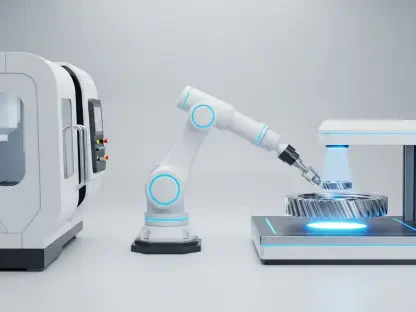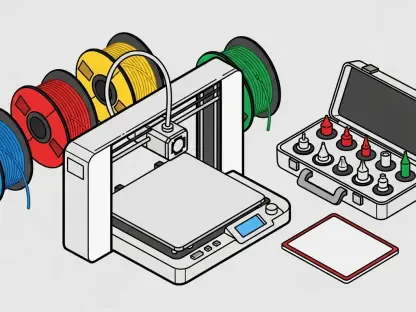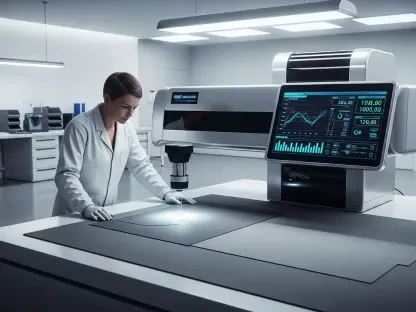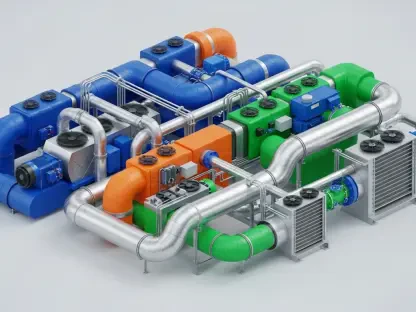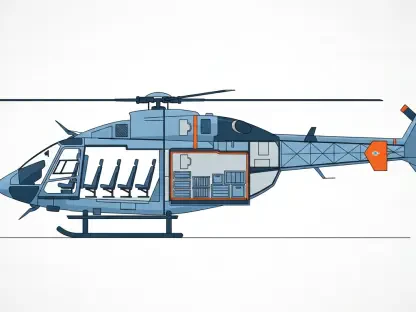Unveiling the Stakes in Additive Manufacturing
In a landscape where innovation meets economic turbulence, the additive manufacturing sector stands as a critical battleground for technological advancement and market resilience, especially for key players like 3D Systems. Based in Rock Hill, South Carolina, this cornerstone of the industry has reported a striking 16% year-over-year revenue decline to $95 million for Q2, yet an astonishing 84% growth in its aerospace and defense segment. This dichotomy raises pivotal questions about the forces shaping the market and the sustainability of niche successes amidst broader downturns. Why does such a disparity exist, and what does it signal for the future of 3D printing technologies?
This analysis aims to dissect the latest financial performance of 3D Systems, placing it within the broader context of market dynamics and economic pressures. By exploring the interplay between declining overall demand and robust sector-specific growth, the discussion seeks to uncover actionable insights for stakeholders navigating this complex terrain. The importance of understanding these trends cannot be overstated, as they reflect not only the health of a single company but also the direction of an entire industry under strain.
What follows is a deep dive into current market patterns, data-driven insights, and forward-looking projections that could redefine strategies in additive manufacturing. From macroeconomic hurdles to operational pivots, this examination offers a lens into how companies like 3D Systems are adapting to survive and thrive. The stakes are high, and the insights gleaned here could prove instrumental for investors, industry players, and technology advocates alike.
Decoding Market Trends and Financial Realities
Industry Headwinds: A Broader Economic Struggle
The additive manufacturing sector is grappling with significant challenges as economic uncertainty continues to suppress capital expenditure across multiple industries. A pervasive softness in customer spending, driven by factors such as tariff volatility and disrupted supply chains, has led to a consistent decline in demand for new production capacity. For 3D Systems, this translates directly into a 16% drop in quarterly revenue, reflecting a trend that mirrors the struggles of many peers in the space. This market-wide slowdown underscores the fragility of growth in an environment where businesses hesitate to invest amid unpredictable costs.
Beyond immediate financial impacts, the broader implications of these headwinds suggest a prolonged period of caution among manufacturers. Industries outside high-growth niches are scaling back on adopting advanced technologies, prioritizing short-term stability over long-term innovation. This conservative approach poses a structural challenge for companies reliant on widespread adoption of 3D printing solutions, pushing them to seek alternative pathways to revenue generation in a constrained market.
Aerospace and Defense: A Niche Powerhouse
Contrasting sharply with the general downturn, the aerospace and defense segment emerges as a beacon of growth for 3D Systems, boasting an 84% year-over-year revenue increase and a 53% sequential rise in Q2. This surge highlights a growing dependence on additive manufacturing for producing complex, lightweight components critical to these industries. The ability to rapidly prototype and customize parts aligns perfectly with the needs of aerospace firms, positioning 3D Systems as a vital partner in an area where precision and innovation are non-negotiable.
However, this success comes with inherent challenges that temper unbridled optimism. Long sales cycles and stringent regulatory requirements in aerospace and defense can slow the pace of revenue realization, even as demand grows. Additionally, the heavy reliance on a single high-performing sector raises questions about diversification and risk management, especially if geopolitical or budgetary shifts impact defense spending in the coming years. Balancing this growth with broader market exposure remains a critical concern.
Financial Maneuvers: Cost Cuts and Profit Gains
Amid revenue challenges, 3D Systems has turned to aggressive cost-saving measures to bolster its financial standing, a strategy that has yielded notable results. Initiatives rolled out earlier this year slashed operating expenses by over $20 million in Q2, directly enhancing gross margins and driving a remarkable $131.7 million improvement in net income to $104.4 million. Strategic moves, such as divesting the Geomagic software platform and retiring debt at a discount, further underscore a commitment to restructuring the balance sheet for stability.
Despite these gains, profitability metrics reveal a mixed picture that warrants caution. Adjusted EBITDA, while improved by $7.6 million from last year, remains negative at a loss of $5.3 million, signaling that full financial recovery is still a work in progress. The risk of overzealous cost-cutting, particularly if it hampers investment in research and development, looms as a potential threat to sustaining competitive edges in a technology-driven field. Striking the right balance between efficiency and innovation is paramount for long-term success.
Projecting the Future: Opportunities and Risks
Emerging Trends: Technology and Sectoral Shifts
Looking ahead, the additive manufacturing landscape is poised for transformation driven by technological advancements and sector-specific demands. The continued adoption of 3D printing in aerospace and defense, fueled by needs for customized solutions and rapid production, offers a clear growth trajectory for companies like 3D Systems. Innovations in printing speed and material diversity could further amplify this trend, potentially expanding applications into adjacent high-stakes industries if cost barriers are addressed.
Another promising avenue lies in the integration of artificial intelligence and automation into 3D printing workflows, which could enhance scalability and precision. However, the upfront costs of such technologies may deter smaller players or delay widespread adoption in a capital-constrained environment. For 3D Systems, maintaining a focus on R&D while managing financial discipline will be crucial to capitalize on these emerging opportunities without overextending resources.
Economic and Regulatory Uncertainties
On the horizon, macroeconomic and regulatory factors present both risks and potential catalysts for the industry. Persistent tariff uncertainties and global trade tensions could continue to suppress customer confidence, impacting demand outside niche sectors. Conversely, government incentives for advanced manufacturing, particularly in defense, might provide a much-needed boost, especially if policies align with national security priorities over the next few years, from this year to 2027.
The interplay of these external forces suggests a volatile outlook that demands agility from market participants. Companies must prepare for scenarios where economic recovery lags or accelerates unexpectedly, adjusting production and investment strategies accordingly. For 3D Systems, diversifying client bases and geographic markets could mitigate risks tied to specific policy shifts, ensuring resilience against unpredictable headwinds.
Strategic Outlook: Balancing Growth and Stability
Projecting into the near future, a cautiously optimistic stance emerges for 3D Systems, with leadership targeting positive cash flow by 2026 through sustained cost initiatives and sector growth. This goal hinges on maintaining momentum in aerospace while stabilizing broader revenue streams, a delicate balancing act given current market softness. Industry observers note that firms prioritizing operational efficiency alongside targeted expansion are best positioned to weather ongoing challenges and seize recovery opportunities.
Speculatively, partnerships with key aerospace players or entry into emerging defense applications could solidify 3D Systems’ foothold in high-growth areas. Yet, the overarching need to address negative EBITDA and rebuild investor confidence in core markets remains a pressing priority. The path forward will likely involve a blend of tactical cost management and strategic bets on innovation, setting the stage for a dynamic evolution in competitive positioning.
Reflecting on Insights and Charting Next Steps
Looking back on the analysis of 3D Systems’ Q2 performance, a narrative of contrast and adaptation emerges as the company navigates a 16% revenue decline while achieving an 84% surge in aerospace and defense. The financial restructuring, marked by over $20 million in cost savings and a $104.4 million net income boost, demonstrates a proactive stance against economic pressures. These outcomes paint a picture of resilience, where niche strengths offset broader market weaknesses.
The implications of these findings point to a pivotal moment for stakeholders in additive manufacturing, urging a recalibration of strategies to prioritize high-growth sectors. A key takeaway is the necessity of balancing cost efficiency with sustained innovation to avoid long-term competitive setbacks. This dual focus offers a blueprint for navigating similar challenges faced by other industry players during this period.
Moving forward, actionable steps include forging strategic alliances in aerospace to lock in demand, while exploring diversification into adjacent markets to buffer against economic volatility. Investors and businesses are encouraged to monitor policy developments closely, particularly around trade and defense spending, to anticipate shifts in market dynamics. Ultimately, the journey of 3D Systems in this quarter serves as a reminder that adaptability, paired with targeted growth, remains essential for thriving in an uncertain industrial landscape.



